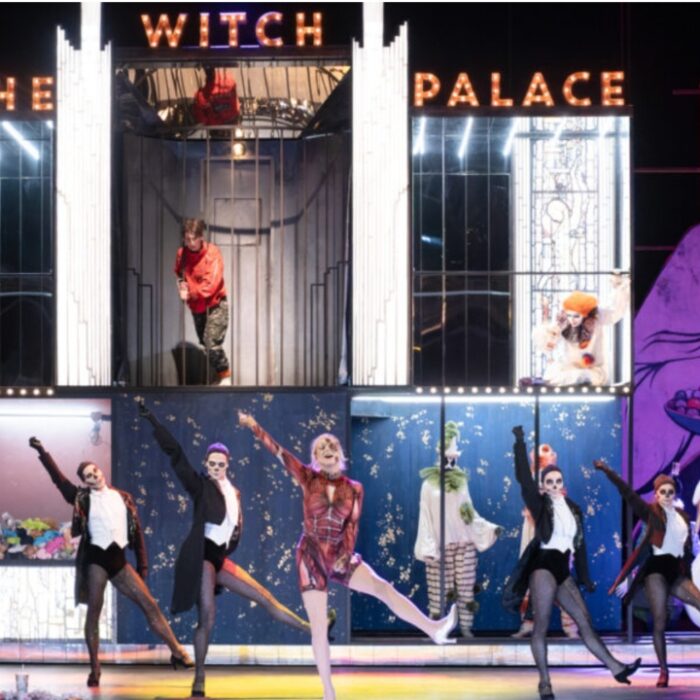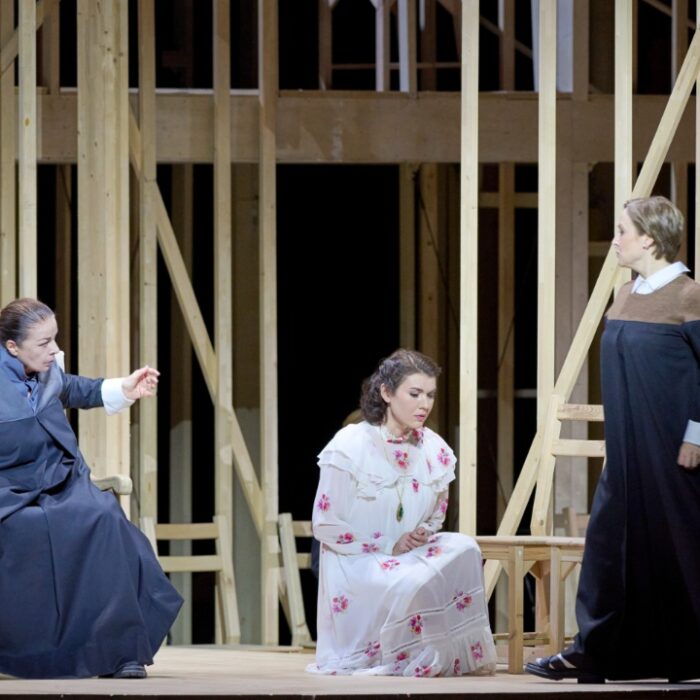
Royal Opera House 2024-25 Review: The Tales of Hoffmann
Director Damiano Michieletto’s Opera Fantastique Production Illuminates Offenbach’s Masterpiece
By Mike Hardy(Photo ©2024 Camilla Greenwell)
In a recent interview with director Damiano Michieletto at the Venice production of “The Tales of Hoffmann,” he said: “At its heart it is a journey into fantasy. It is opera fantastique, after all!”
One definition of the French word fantastique is: a term for a literary and cinematic genre and mode that is characterized by the intrusion of supernatural elements into the realistic framework of a story, accompanied by uncertainty about their existence. And this definition fits THIS production of Offenbach’s final work to absolute perfection.
Illuminating Production Details
The production includes an animated giant eyeball overlooking grown, mature adults in a classroom setting replete with school-boy shorts, ballet performing horned devils with purple sparkly partial body stockings, sparkly red horns and matching nipple tassels. The narrator-cum-muse to Hoffmann, Nicklausse, is dressed as a vividly colourful PARROT…..and we’re STILL only in the first act!
Later, throw in a few dancing mice accompanied by a giant, stilt walking “pied-piper,” a carpet-bag carrying green fairy, revolving and incarcerating wall mirrors and you have a Michieletto masterpiece. Surreal? Think Salvador Dali meets “Alice in Wonderland.”
Probably one of the most visually spectacular performances seen at the Royal Opera House, this is a cornucopia of dazzling splendour, a veritable feast for the eyes as well as the ears. Paolo Fantin’s sets, though by necessity minimalist, employ a simple, multi-level order which proves most impactful and enhances the tale the way split-screen story telling should.
Alessandro Carletti provides remarkable lighting with striking and vivid hues, bold, compartmentalized multi-level sets with strong greens, reds and blues, seemingly at times as though the Aurora Borealis had managed to seep onto the stage. The expanding and contracting spotlighting intensified the narrative and served to highlight the tensions. This did MORE than just illuminate. The clever employment of projected shadows was especially effective among the dance routines.
Costume designer Carla Teti and her team did a sterling job, emblazoning the sets with vivacious colour and shimmer, producing wonderful, wacky and downright weirdness when called for.
Such intricate and elaborate designs, then, for the simplest of stories; that of one man, Hoffmann, reflecting on the three, principal lost loves in his life through an alcohol induced haze.
Stunning Cast
Peruvian superstar tenor Juan Diego Flórez is a renowned and acclaimed leading bel canto singer who has expanded into more verismo roles as of late. In the titular role of Hoffmann, Flórez moves with athletic ease and exudes boyish charm. His voice is exquisite with a secure ringing top. Alas, I frequently find his voice lost among the crowd, or among the orchestration. However, he has the most beautiful of instruments that spins divine legato lines. His rendition of the keynote aria, “Il était une fois à la cour d’Eisenach,” in the Prologue was polished and proficient.
His second act interactions with his second love, Antonia, are touching. But he really rose to prominence in the final act where his “O Dieu! de quelle ivresse” displayed his wonderful lyrical legato to perfection. Flórez also has great characterization skills. His interactions with his first love, Olympia the doll, were enchanting and endearing. He is a great exponent of comedy when needed, almost Chaplinesque in some of his expressions and attitudes. He is unquestionably still a major force in opera, but it remains to be seen whether he can adapt his voice to take on more demanding and heavier roles than those in which he has already triumphed.
No such vocal projection issues were apparent in the armoury of Italian bass-baritone, Alex Esposito. Sonorous, often treacle dark, but always richly resonant, he played the roles of Lindorf, Coppélius, Dr. Miracle and Dappertutto. Vocally impressive at all times, Esposito delivered his lines with authority and conviction. Not just a vocal powerhouse, his acting skills were superb here. He is a wonderful mix of pantomime villain, Doctor Evil and Nosferatu. Esposito displayed superb comedic gifts in his countenance and timing. His Max Wall-like promenade onto the stage, accompanied by the line “It’s me!” as an aside to the audience was fabulously funny, as was his reincarnation in Act three from his hanging over the edge of the stage position where he had previously expired. Not just witty and comical, but also capable of real menace and brooding violence. His smashing of a full-size cello, drug-addled rock guitarist style, was shockingly breath-taking. He was a real tour de force here, deserving of all plaudits.

©2024 Camilla Greenwell
The Tales of Hoffmann at The Royal Opera House, Monday 4th November 2024. Directed by
Damiano Michieletto, conducted by Antonello Manacorda. Cast: Juan Diego Flórez, Alex Esposito, Olga Pudova, Ermonela Jaho, Marina Costa-Jackson.
More Cast Highlights
If this were a competition, any judge worth their salt would have a tough time picking a winner from the plethora of remarkable talent on show, courtesy of the ladies in this production. Certainly, at curtain call, Albanian soprano Ermonela Jaho just edged it in the applause stakes. Her portrayal of Hoffmann’s second love, Antonia, was deeply poignant and piteous. Her consigned malady, a crippling disease requiring a wheelchair, made little sense with regards to her having to NOT sing as it may kill her, (as the story demands), as her character is usually consumption stricken.
However, this production has her as a former DANCER which makes for a far more visually impactive condition but doesn’t correlate with her having to abstain from singing. No matter, she produces pure liquid gold here in a heart wrenching performance where she digs deep to produce the whole gamut of her skills. Jaho is especially exquisite when singing melting soft pianissimos. Her ability to sustain beautiful lines whilst supporting her whole body weight on crutches, and convincingly dragging her useless legs behind her was an astonishing feat of athletic prowess. Her broken body, lying on the floor, desperately reaching out to a very young child ballerina enacted her as a child, always just out of reach. This was a triumph of stage direction and acting.
On the night, however, the loudest, longest and most vociferous applause at the end of her aria, “Les oiseaux dans la charmille,” was awarded to Russian coloratura soprano Olga Pudova who unquestionably stole the show. She sang with extraordinary agility and dexterity, throwing off wonderful trills in all directions. Moreover, her mechanical movements were all the more convincing and realistic by virtue of not adopting the usual “robotic” staccato movements usually favoured. Instead, she utilized a curious, coordinated gait that positively elevated the authenticity of the role. Here in her Royal Opera House debut, she surely couldn’t have wished for a more illustrious or memorable start.
Hoffmann’s FINAL love, Giulietta, was played by Italian American soprano Marina Costa-Jackson. Getting the glamour spot, dressing in a fine, gold dress and with blonde curls, she cut a most sensual figure, redolent of Marylin Monroe. Her solid soprano was most expansive and voluminous. I detected a lack of refinement in one or two passages, almost certainly early nerves, but she soon settled to produce wonderful full, creamy rich tones. Her “L’amour lui dit la belle” was consummate and her duet in the most famous piece from the opera, “Belle nuit, ô nuit d’amour” was exceptional.
Her partner in that duet, French-Canadian mezzo-soprano Julie Boulianne plays the role of the muse, Nicklausse, Hoffmann’s guide and friend. Her incarnation here sees her embodying a parrot which she carries around in a cage, but she also is attired with bright and colourful costumes, and wings for good measure. This facilitates her flitting and flapping around the stage in adolescent bursts of energy, mimicking the exotic bird she is portraying. Vocally resplendent, with a smorgasbord of rich mezzo-soprano colours, her duet already alluded to; she delivered a beautiful and most impassioned “C’est l’amour vainqueur” in the Antonia act. For me, this was one of the most moving moments in the opera.
French tenor Vincent Ordonneau played a delightfully enchanting and comedic Spalanzani, inventor and short-lived “owner” of the Olympia automaton.
At extreme ends of the emotional scale, we had Alastair Miles as Crespel, Antonio’s father, a stentorian bass delivering wonderful phrasing and dark colours, embodying all the qualities needed to depict a heartbroken father presiding over his daughter’s demise.
At the other end, French tenor Christophe Mortagne, as Frantz, is a deliciously and hilariously camp ballet teacher who gets to be taunted by a very young ballet ensemble who torment him when he’s not watching them. This is a hilarious and heart-warming section, in equal measures.
Special mention must go to Welsh tenor Ryan Vaughan Davies whom I thought was arresting in his role as Nathanael, presenting a fine, bright, clarion tenor instrument that left me positively wanting to hear more. A fairly recent entrant to the Jette Parker Artists program, unless my ears deceive me, I predict big things for him.
Another voice I longed to hear more of belonged to British mezzo-soprano Christine Rice who was most exquisite as the spirit of Antonia’s mother and as the Muse of Poetry who gets to open every scene, sprinkling her shimmering magic as she does so.
Of the remaining roles, Royal Opera stalwart Jeremy White as Luther provided excellent support with his excellent bass voice.
Talented & Gifted Choreography
This production encompassed many dance sequences, courtesy of the Royal Ballet, whose gifted dancers featured in every act, were wonderfully choreographed by Chiara Vecchi. Their contribution to the opera proves invaluable in the telling of Hoffmann’s tales, excepting perhaps some rather salacious and unnecessary lewdness from the prancing horned devils. I was particularly enamoured by the very youngest of dancers, perhaps as young as seven or eight. A special mention must go to Beatrice Hope Henley, a TRUE “Tiny Dancer,” who got to play the role of the very young Antonia. She danced fearlessly and beautifully for one so young. Her performance served to massively enhance and augment the emotional context of the whole act.
The Royal Opera House never fails to impress and, on this occasion, they were astounding, especially in the prologue and epilogue.
The opera house orchestra was as buoyant and sumptuous as ever, and I feel that they, under the baton of Antonello Manacorda had much to do here to keep the score, with such a frantic and very busy production, all in time.
Offenbach never lived to see his opera come to fruition, dying as he did, with the score in his hands before its opening. One wonders whether the outlandish and wondrous visions that compelled him to write “The Tales of Hoffmann” matched those of Michieletto’s vision. Opera fantastique? Opera fantastic!



